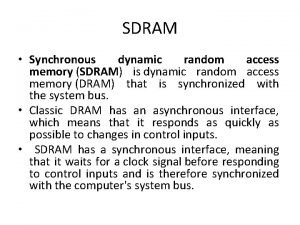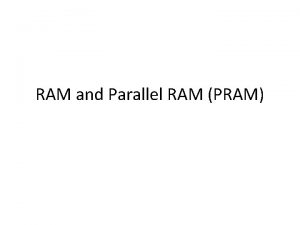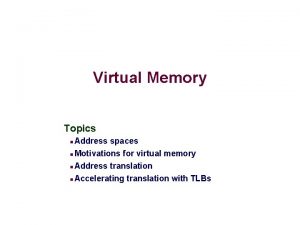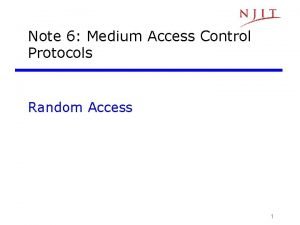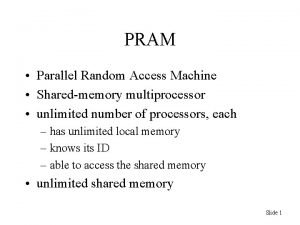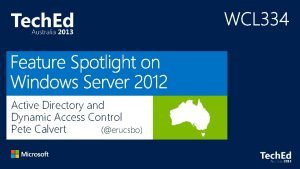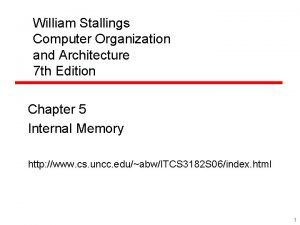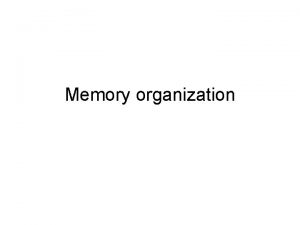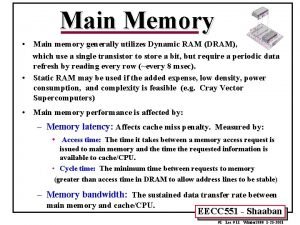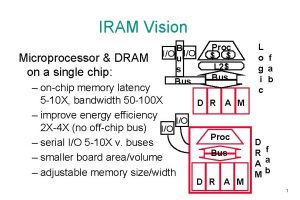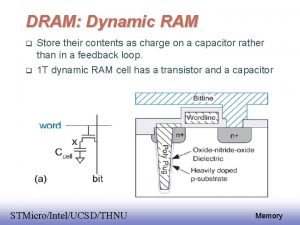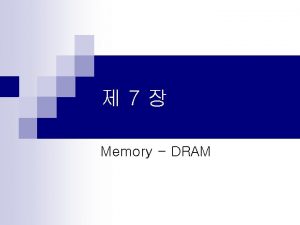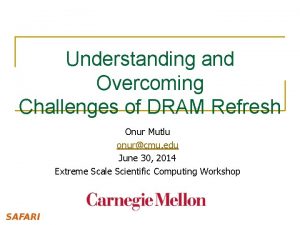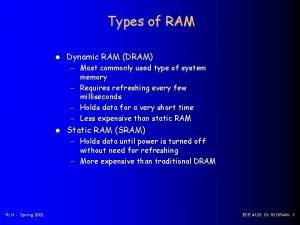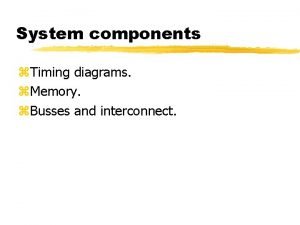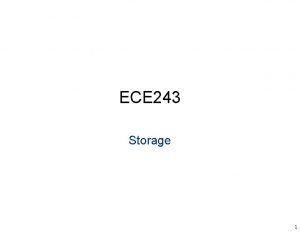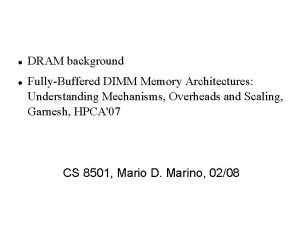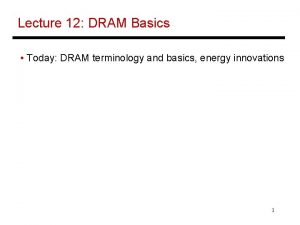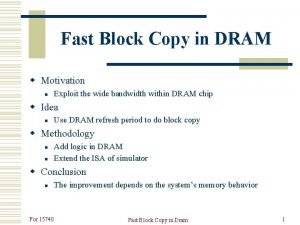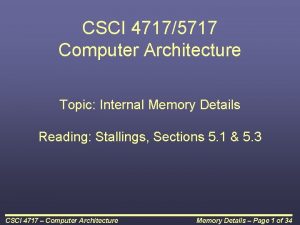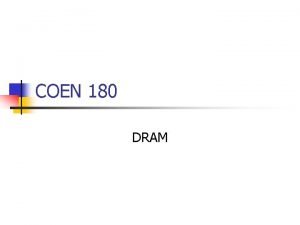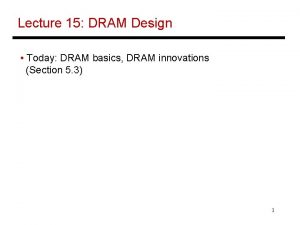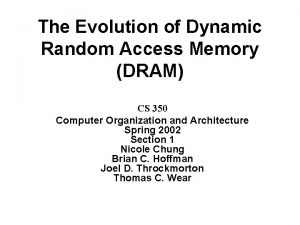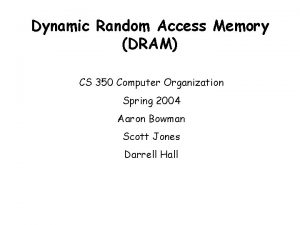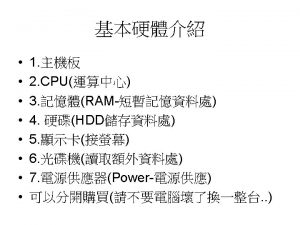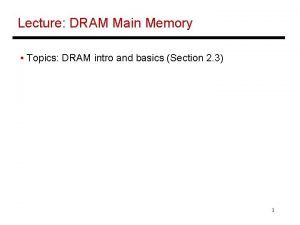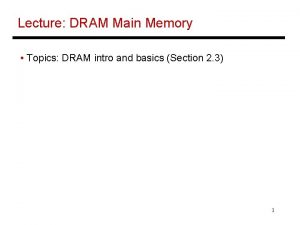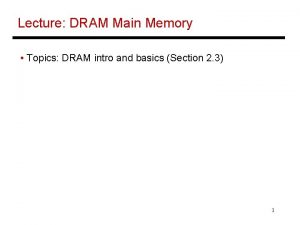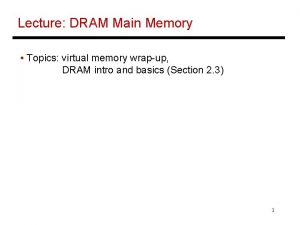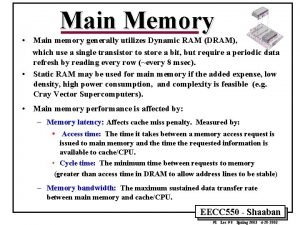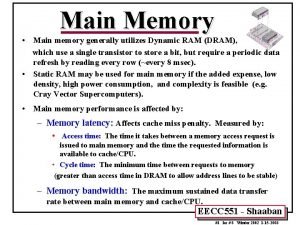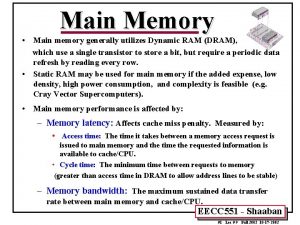Memory DRAM Dynamic random access memory Main form



































- Slides: 35

Memory

DRAM Dynamic random access memory � Main form of memory in personal computers and game consuls � Stores each bit of data in a separate capacitor within an integrated circuit �

DRAM Capacitor can be either charged or discharged � Called dynamic memory because if capacitors must be periodically charged � If not charged the information stored in the capacitors will eventually be lost �

DRAM Type of memory used by the CPU � Each chip holds rows and columns of data � A DRAM chip that holds 1, 048, 576 rows and 8 columns would be 1 M x 8 chip � › “M” means megabyte Originally RAM came in one bit wide sticks � Now RAM is available in 32 -bit and 64 -bit sticks �

DRAM Advantages � Structural simplicity › Only one transistor and one capacitor per bit �SRAM has sic transistors � Inexpensive � Small to manufacture in size � Can hold larger amounts of information

DRAM Disadvantages � Loses data when power is removed � Because data needs to be refreshed it is slower than SRAM

SRAM � Static random access memory � Memory is lost once the power is lost � Typically find that SRAM is used in: › › cache memory, hard drive buffers and in other electronics such as children's toys Electronic games

SRAM Advantage � Does not loses data when powered down � Date does not need to be continuously refreshed � Faster then DRAM

SRAM Disadvantage � Expensive to manufacture � Larger than DRAM

SDRAM � Synchronous dynamic random access memory � Because it is synchronous it is tied to the system clock � Allows for higher transfer rates with interfaces possible � Has to wait for a clock signal before it can respond to control inputs and synchronize with the computer

SDRAM � Introduced in 1996 on a dual inline memory module stick (DIMM) � Had varying number of pins � DIMM slots that stored the memory referred to as “banks”

SDRAM Advantages � Allows computers to run at higher mega hertz � Extremely protective of data bits that are stored into the computer › This means it will not allow any corrupt material to be stored in it's drives. � Uses pipelining › that allows more then one command to be accept at one time

SDRAM Disadvantages � Not good at checking to ensure that electrons in the computer system are working properly › This means it needs to be constantly refreshed to ensure that no information is not lost

RAMBUS � Leader in the computer memory industry � Develops and licenses high-performance memory logic and circuit design technology and provides licensees with product design � Created RDRAM

RDRAM Developed for the Pentium 4 by Rambus � Can handle speeds up to 800 MHz � Not well accepted by the industry because of high cost and production delays �

RDRAM � Came in two sizes › 184 -pin (desktops) › 160 -pin (laptops) � Had speed ratings of 600 MHz, 700 MHz, 800 MHz, or 1066 MHz � Had to be installed in pairs because it alternated between two stick to increase speed

RDRAM � All slots on motherboard had to be populated � Roadblocks faced by RDRAM › Technology was owned entirely by Rambus › Expensive › Rambus and Intel made a closed deal and RDRAM only worked on Pentium 4 systems using Intel

DDR SDRAM � Double data rate � Same principle as RDRAM › Doubled speed by making two processes for every clock cycle � Cost only slightly more than regular SDRAM � 184 -pin for desktops � 172 -pin or 200 pin for laptops

DDR SDRAM � Sticks are notched so that the wrong stick can not accidentally be placed in the wrong slot � Eventually became adopted as the standard system RAM � In 2003 Intel ceased producing for RDRAM and adopted SDRAM � Fastest version ran at 4. 8 gigabytes per second

DDR 2 Successor to DDR � Runs faster than DDR by clock-doubling the input/output circuits � Uses less power � Uses 240 -pin DIMM which is not compatible with DDR �

DDR 3 � Newest in line of DDR � More efficient architecture � 30 percent lower power consumption � Uses a 240 -pin DIMM, which is slotted differentially which prevents users from installing the wrong ram � Double the buffer of DDR 2 from 4 to 8 bits

DDR 3 � Extending memory profile (xmp) › Enables RAM to be overclocked � Triple-channel memory › Works like dual channel but uses three sticks instead of two

DDR / DDR 2 / DDR 3 � Double data rate � Neither forwards or backwards compatible � Double data rate means that DDR can achieve nearly twice the bandwidth of a single data rate (SDR) SDRAM running at the same clock frequency, due to this double pumping. DDR 1

DDR 2 Versus DDR 3 � http: //www. youtube. com/watch? v=m. ZAQ 4 Y 0 tjts&feature=related

Single Sided and Double Sided � Single sided have chips on only one side of the sick � Double sided have chips on both sides of the stick � Majority of sticks are single sided � Some motherboards are not compatible with double sided ram

Latency The delays incurred when a computer tries to access data from the stick of RAM � The latency number reflects how many clicks of the system clock it takes before the RAM responds � Sticks with lower latency are “faster” because they have smaller delays � One stick with lower latency may cost far more than a the same stick with a higher latency �

Parity vs. Non-parity � Parity RAM was the first form of error detecting RAM � Uses for computers that must be precise all the time � On occasion there will be an error, parity RAM detects the error

ECC vs. non-ECC � Error correction code � Detects any time a single bit is incorrect � It fixes any errors on the fly � ECC RAM is slower than non-ECC RAM because of the error checking � Non- ECC RAM does not do error checking

Single channel vs. dual channel � Dual channel is faster and allows for more DIMMs � Dual channel means that you have two channels/pathways for your CPU to access your RAM r � Single channel means there is only one channel � More channels allows for more data to be transferred which results in more speed

Installing RAM � http: //www. youtube. com/watch? v=pem. Qxh. E 7 Jhk

Install and configure peripherals and input devices � The following should automatically configure, or only need their attached installed CD to configure › › � If Keyboard Bar code reader Multimedia Mouse will not configure you may need to download a driver

Biometric Authentication � Uses some sort of physical characteristic to identify the user, such as › › Face Eye Fingerprint Handprint � Free face recognition software: › http: //www. youtube. com/watch? v=h. Uc_2 OR 7 z. Q 8

Touch screen �A touch screen allows the user to physically touch the screen to open, close and move through an application � http: //www. youtube. com/watch? v=6 jho. Ws. H w. U 7 w&feature=related

KVM Switch The KVM Switch allows the user to access different computers using a single monitor, keyboard, and mouse. � KVM stands for Keyboard, Video, and Mouse � When installing turn off all computers that will be connected. � Connect all computers to the switch then turn back on the computers. � Windows should recognize the new devices and automatically install them. �

Helpful Links � http: //www. youtube. com/watch? v=E 4 PIDZr. B Gz. Q � http: //www. youtube. com/watch? v=r. Twx. XHswb. E
 Synchronous dynamic random access memory
Synchronous dynamic random access memory Parallel ram
Parallel ram Advantages and disadvantages of array over linked list
Advantages and disadvantages of array over linked list Virtual memory
Virtual memory Dram memory mapping
Dram memory mapping Random assignment vs random sampling
Random assignment vs random sampling Random assignment vs random selection
Random assignment vs random selection Advantages of serial file organization
Advantages of serial file organization Random access control
Random access control Channel partitioning protocols
Channel partitioning protocols Random access adalah
Random access adalah Multiprocessor
Multiprocessor Dynamic dynamic - bloom
Dynamic dynamic - bloom Active directory dynamic access control
Active directory dynamic access control Terminal access controller access control system plus
Terminal access controller access control system plus Terminal access controller access-control system
Terminal access controller access-control system Semiconductor ram memories in computer organization
Semiconductor ram memories in computer organization Azerbaycanda ilk dram eseri
Azerbaycanda ilk dram eseri Dram timing parameters
Dram timing parameters What is internal processor memory
What is internal processor memory Cache
Cache Appistore
Appistore Dram
Dram Dram organization
Dram organization Dram in computer architecture
Dram in computer architecture Dram ras cas
Dram ras cas Dram refresh failure
Dram refresh failure Types of drams
Types of drams Dram puf
Dram puf Dram timing diagram
Dram timing diagram Dram scaling challenges
Dram scaling challenges Dram cell
Dram cell Dram
Dram Overfetch
Overfetch Dram block diagram
Dram block diagram Advanced dram organization
Advanced dram organization
